Last Updated on May 2, 2023 by Aaron von Frank
We’ve been foraging morel mushrooms in the southeast US for over a decade. Our guide to finding morels in the southeast will help you find these delicious mushrooms too!
What is a morel mushroom?
Morel mushrooms are a genus (Morchella) of prized culinary mushrooms with a distinct sponge-honeycomb texture on their caps. Different species of morels can be found in temperate climate regions around the world, including in the southeastern United States.
Morels are believed to be both mycorrhizal and saprotrophic. That means they form symbiotic relationships with their host trees and they also consume decaying organic matter.
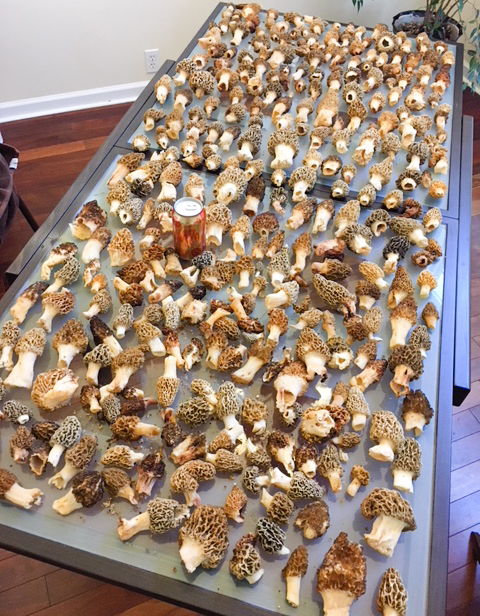
A nice haul of morel mushrooms foraged in the southeast US – South Carolina to be exact.
How many species of morel mushrooms are there in North America?
A 2015 molecular phylogenetic analysis determined there were 22 species of morel mushrooms in North America. A 2017 analysis put the number of North American morel species at 19.
So, the short answer is there are probably at least a couple dozen species of North American morel mushrooms. Perhaps future phylogenetic analyses will reveal additional regional species and subspecies.
Why do people like morel mushrooms?
Morel mushrooms are hugely popular for the following reasons:
- They are a delicious fungi highly regarded by gourmet chefs and home cooks alike;
- They’re very difficult to cultivate so they have to be foraged (and some say cultivated morels lack the flavor of those in the wild with mycorrhizal relationships);
- They only fruit (aka produce above ground mushrooms) during a short time window each year.
In short, scarce supply and high demand drives the huge popularity of morel mushrooms.
How do you eat morel mushrooms?
There are countless ways to eat morel mushrooms, from sweet to savory. We’ve offered some of our favorite morel mushroom recipes elsewhere.
As a general rule: morels pair well with milder foods: chicken, white wine, parmesan… You wouldn’t serve morels with red meat, tomato sauce, red wine, etc. because their subtle, nuanced flavors would be drowned out.
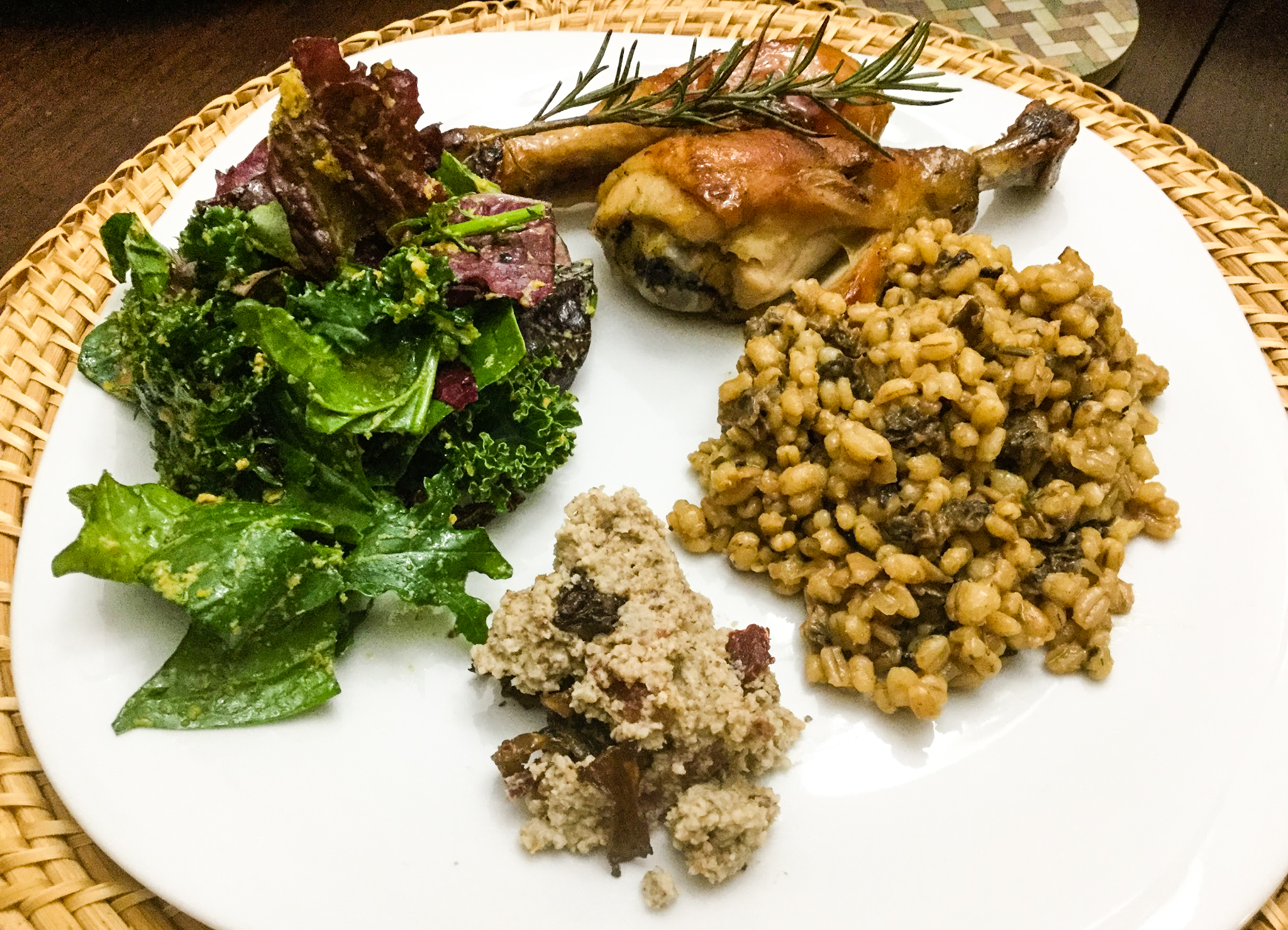
A nice homemade morel dinner. Morel mushroom pate (front), morel mushroom farrow (right), morel-honey glazed chicken, and garden-fresh salad with crispy, pan-fried morels. Candied morel torte was served for dessert.

Another dynamite morel recipe: morel mushrooms with stinging nettle pasta, redbud flowers, and poached duck eggs.
Yes, morel mushrooms can be made into sumptuous desserts. In addition to the morel torte mentioned above, a simple and delicious morel mushroom dessert recipe we love is maple-candied morel mushrooms dipped in spruce needle whipped cream.

Maple-candied morels are a simple and fast morel dessert recipe you’ll love. Dip them in spruce needle whipped cream for the taste of a spring forest.
What do morel mushrooms taste like?
The taste of morel mushrooms is subtle, not strong. They’re nutty and earthy with a slight hint of sweetness. While morel mushrooms are uniquely delicious, they don’t have the flavor intensity of other popular edible fungi like truffles or black trumpets.
Do different species of morels taste different?
We’ve eaten multiple species of morels and haven’t found there to be much difference in flavor between them. We personally prefer the large blonde Morchella esculenta due to their relative thickness and ability to be stuffed with savory fillings.
Smaller morel varieties are generally thinner-walled and not large enough to stuff. (More on morel types below.)
Do you have to cook morel mushrooms?
Yes, morel mushrooms have to be well-cooked before they can be safely eaten. Never eat raw or under-cooked morels.
It’s also best to avoid ingesting a large quantity of cooked morels and a large quantity of alcohol at the same time. We found this out the hard way during a special 8-course meal, where each course featured morel mushrooms paired with a different beer — including a morel ice cream dessert. (Part of a writing assignment we did for a magazine.)
Nobody drank to the point of intoxication, but everyone reported feeling various degrees of gastric distress and other unpleasant symptoms afterwards.
How to find morel mushrooms in the American Southeast

Large yellow/blonde Morchella esculenta morels fruiting from the forest floor at one of our secret spots, a low-lying floodplain. Due to their large size and color, these morels are much easier to spot than other smaller, differently colored species of morels which we’ll discuss below.
The only state in the southeast where it’s likely impossible (or close to it) to find morel mushrooms is Florida. The environmental conditions (primarily high temperatures and low winter freeze hours) aren’t hospitable to morels.
The same is true for coastal areas of the southeast, including here in South Carolina. You won’t find morels in Charleston, SC (except at Whole Foods), but move inland 125 miles to Columbia and you’ll start getting into morel mushroom territory.
In the South Carolina Upstate region at the base of the Appalachian Mountains, multiple species of morels thrive. The same is true of finding morel mushrooms in other coastal southeastern states: Georgia, North Carolina, Virginia, Alabama, Louisiana, and Mississippi — you have to go inland.
Morels can be found throughout the landlocked southeastern states of West Virginia, Tennessee, Arkansas, and Kentucky in spots conducive to their growth.

A gorgeous display of morel mushrooms found in the southeast US.
A. Different species of morels found in the southeast
As previously mentioned, there are different species of morels in North America. Likewise, there are also different species of morels in the southeast US.
We’ve found three distinct types of morel mushrooms in the Carolinas. Area foragers lump these morels under the following common names:
1. ‘Blonde’ or ‘Yellow’ morels

This is the largest morel we’ve ever found, a yellow/blonde Morchella esculenta weighing in at close to 1 pound. Her name was Michelle Morchella, and she was loved and appreciated before she was eaten by savages.
Blonde morels are the large early season morels that have a yellow-tan color. Larger ones can be the size of a hand or even a soda bottle. These are likely M. esculenta or at least species within the Esculenta Clade.
Fruiting window: ~3-4 weeks. The earliest we’ve ever seen blonde morels was late February in a very warm year; but they usually don’t appear until the second or third week of March in our area (around Greenville, SC).
2. ‘Tulip’ morels
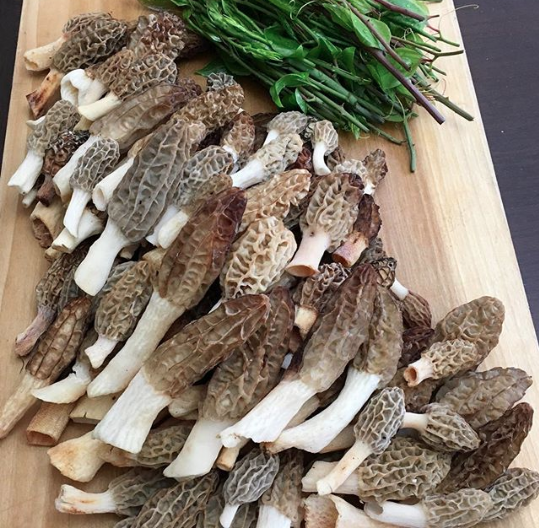
Late season southeastern morels that would be lumped under the common name “tulip morels.”
Tulip morels refers to what is most likely multiple species of smaller morels that start fruiting towards the end of blonde morel season, often associating with tulip populars, hence their name. Species may include M. virginiana, M. diminutiva, M. sceptriformis, and others.
Fruiting window: ~4-6 weeks, persisting into mid to late April, weeks after blondes have stopped fruiting.
3. ‘Half-free’ morels
About a decade ago, we inadvertently chased morel mushroom season up into the mountains of North Carolina. Tulip morel season had terminated around our home in South Carolina so we drove north to visit our aunts who live at the top of a mountain outside of Asheville, NC.
We were thrilled to discover the edges of their gravel driveway adjacent a mature hardwood forest brimming with tulip morels. We were also thrilled to find our first ever half-free morels (Morchella punctipes) emerging from the soil of an embankment there. (They’re called half-free morels due to the way the caps overhang the stems.)
Half-free morels are much smaller than M. esculenta. They feature long white stems and small tan caps, giving them a rather phallic shape. You can use your imagination to figure out the colorful names that local foragers call them.
We’ve never found Morchella punctipes in South Carolina.
B. WHEN do morel mushrooms fruit in the southeast?
In the southeast, morel mushrooms fruit from late winter through early spring.
Morel mushroom sighting maps will help you determine whether morel mushrooms have started fruiting in your area.
Ideal temperatures for morel mushrooms
As a general rule, morels fruit in response to soil temperature changes. Warming weather in late winter through early spring triggers the underground morel sclerotia to initiate fruiting.
Ideal soil temperatures for morel mushrooms are 53-59°F which means daytime high temperatures have started getting into the 70s.

A nice haul of morel mushrooms harvested on a mild March day in the Carolinas.
Other factors that can impact fruiting times of morels:
Species type – As reference above, different morel species fruit at slightly different times.
Weather – Cold years or warm years can shift the initiation of morel fruiting by 2-3 weeks from the norm in either direction.
Exact location/microclimates – Microclimates are spots that are warmer, cooler, wetter, drier, sunnier, or shadier than the surrounding area. Microclimates impact fruiting times of morels.
An example of a large microclimate is the heat-trapping effect of a city due to the acres of concrete and asphalt which absorb more heat from the sun than a forest ecosystem would. We’ve seen morel mushrooms in parks in downtown Greenville, SC, weeks ahead of when we see them in rural forest settings outside of the city.
The same principle applies when you’re in the woods… One side of the creek or river you’re foraging may not have morels, but they may be fruiting on the other side due to differences in sunlight, soil temperature, and soil moisture.
Elevation is yet another example – morels may be fruiting in a valley but not yet fruiting at the peak of a mountain.
C. WHERE do morel mushrooms fruit in the southeast?
Here’s the conventional wisdom for how to find morels in the southeast US — and the wisdom that we generally follow when looking for new morel foraging spots: look in low-lying floodplains with lots of mature hardwoods, especially elm, ash, and sycamore trees. These guidelines are pretty good at helping you identify spots to find large blonde morels, Morchella esculenta.

A photo from one of our best morel spots. The land on both sides of this creek features mature deciduous forests with lots of morels fruiting in March each year.
But finding morels isn’t so simple. Spots we think will be full of morels sometimes don’t have any. Spots we think aren’t worth checking out have been loaded.
One of the most abundant M. esculenta morel spots we’ve ever come across was at a friend’s private hunt club where baskets full of morels seemed to be associating with one large oak tree. ‘Tulip’ type morels seem even less inclined to pay attention to general wisdom: if there are tulip poplar tree roots nearby, they can be found in grassy lawns, trail edges, or steep hillsides.
Morel mushrooms will constantly humble and humiliate your brain’s attempt to detect and predict patterns.

You usually don’t see a cluster of morel mushrooms fruiting together in the southeast, so this is another rare sighting.
Tennessee Evan’s odd morel story
A demonstration of how weird morels can be… Meg and Evan, two of our best friends and fellow foragers, moved to Tennessee when Meg got a teaching/research job at University of Tennessee.
Evan set out to find morel mushroom spots in his new southeastern home. He found some spots using the general wisdom rules detailed above, but a morel mushroom foraging foray with a local mycologist floored him:
“It looked like the absolute opposite of a site we’d identify as a high-probability. The only box it ticked was that the soil is sandy, well-draining, and somewhat disturbed around the trails. Most of the trees were probably no more than 8 inches in diameter and they were all conifers, Eastern red cedars (Juniperus virginiana) to be exact.”
Again, just when you think you know what morels are going to do, they humble you. In this case, it was an unknown species of grey morel that thumped Evan’s neocortex.
Do southeastern morels fruit in burn sites?
In other regions, certain species of morel mushrooms fruit prolifically in spots where forest fires (in coniferous forest) occurred the prior year. Forest fires are a very rare occurrence in most of the southeast — especially compared to the west coast.
Since we’ve never foraged for morels at a burn site due to lack of actual forest fires, we can’t say whether the species of morels in our region fruit more prolifically as a result of such environmental conditions.
Our best guess? Southeastern morels are adapted to our specific bioregion and therefore would not respond differently/favorably to forest fires since they’re such a rare occurrence, thus making such an adaptation unnecessary.
Tips for spotting morels
One thing all morels have in common: they’re devilishly hard to spot due to their color and texture, which provide wonderful camouflage. Countless times, we’ve spotted morels right where another of our eagle-eyed foraging friends has walked — and vice versa.
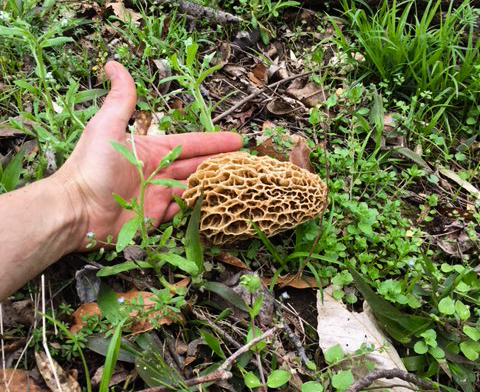
Gotcha! A gorgeous blond morel emerging from the forest floor in a patch of chickweed and other edible weeds.
Likewise, you can walk carefully one way down a path and not notice the dozens of morels you walked over that were only visible after reversing course and retracing your steps.
6 tips for spotting morels once you’ve arrived at a spot that looks promising:
- Walk slowly.
- If multiple people are along, fan out so as to cover the area as completely as possible.
- Periodically squat down and try to spot morels popping out above the forest floor – they’re easier to spot from down low.
- If you or someone with you spots a morel, slowly and methodically converge on the spot because there are likely more morels within close visual range.
- Walk more; the more miles you cover the more morel spots (and morels) you’re likely to find.
- Prepare to be humbled by morels’ elusiveness and to have morel dreams for many nights after a good foraging outing.
When you find a morel, cut it just above the soil line with a sharp knife, leaving behind a small stump. (This is NOT how you harvest certain other mushrooms like chanterelles.)

Cutting a morel mushroom stem just above the soil line. Both the stems and caps of morels are hollow, so they’re very delicate mushrooms that should be treated accordingly.
Can you over-harvest morels?
No, you can’t over-harvest morels so long as you put them into a breathable foraging bag or basket. Picking the “fruit” of a morel mushroom does not harm the underground organism.
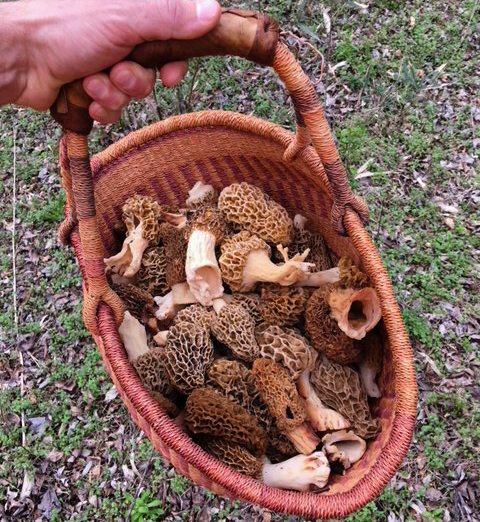
Our favorite foraging basket for morel mushrooms. It’s breathability allows us to spread morel spores as we walk, allowing new morels to grow.
By placing your morels in a breathable bag/basket as you walk, you’re allowing the mushrooms you harvest to spread their spores far and wide, inoculating new spots for the future.
Also, for every one morel you find, chances are there’s at least one (or five) you missed that will drop spores for days or weeks to come. This is why we (and you) can continue to harvest from the same morel spots year after year without any decline in the spot’s productivity.
D. Morel warnings
Before you venture off into the woods, you should heed a few warnings. Ideally, you should also tag along with experienced forager(s) or foraging group your first time to minimize any risks.
1. There are poisonous morel lookalikes
Although they’re exceedingly rare in our area (we’ve never seen one), there are poisonous morel mushroom lookalikes. These are referred to as “false morels” even though they encompass a range of different genera and species.
Thankfully, it’s fairly easy to distinguish between true morels and false morels. Here’s a good overview so you can learn to distinguish between them.
2. Don’t forage morels in polluted spots
As previously mentioned, morels are at least partially mycorrhizal, aka operating in symbiosis with their host trees. One of the many beneficial services they perform for their host trees is drawing any underground contaminants that might be harmful to their host trees to the soil surface and out of the rhizosphere.
Those contaminants are housed in the fruiting body of the mushroom, e.g. the part you eat. In unpolluted areas, there is no risk in harvesting and eating (once well-cooked) morel mushrooms.
However, this feature means you need to be careful not to forage morels in polluted spots, which is easier said than done if a factory that once polluted a river floodplain 50 years ago has long since shut its doors. Likewise, don’t forage morels next to parking lots, roads, asphalt, etc.
Lastly, don’t forage for morels in commercial orchards (morels do associate with apple trees as well). Assuming the orchard has used synthetic pesticides, harmful compounds and heavy metals may be highly concentrated in the soil and thus the morel fruiting bodies.
3. Don’t trespass – and do wear orange in the woods

A common site on private land that looks promising for morel mushroom foraging.
If you see a “no trespassing” sign at a spot that you think is going to make for great morel hunting, heed the wishes of the property owners and stay off the land. You could try to find their contact information using public online tax map information to get their permission to forage.
Many promising looking morel spots in our area are on private hunt clubs. Morel mushrooms are delicious, but not worth being accidentally shot for.
Even if you’re on public land or have permission to forage on private/posted land, we’d encourage you to wear a bright orange shirt, hat, and/or vest to make clear you’re a human, not a game animal.
4. Ticks and snakes
I don’t think I’ve ever gone a morel mushroom season without coming in close proximity to a snake. Usually, these are perfectly harmless rat snakes or king snakes, but venomous snakes are out too. Beware.
Perhaps the greatest risk of foraging is tick bites, and the associated Lyme disease that can accompany them. The Tyrant and I have spent countless hours in the woods and have not gotten a tick bite in 10+ years using a few simple tricks:
- Wear tall rubber boots. Ticks will have difficulty latching on to them.
- Wear plain light-colored clothes, not patterns or dark clothes. It’s very easy to immediately spot a tick crawling on a plain, light-colored shirt versus a dark or patterned shirt.
- If you sit down for a break, immediately wipe off and inspect your clothes for ticks (or have a pal inspect your clothes) afterwards. Also do a visual inspection and wipe down before you get back in your car.
- Take a shower immediately when you get home. There are some spots you can’t ask friends to check.

Fairly dividing up morel mushrooms between foraging friends can get heated! Another risk of foraging morel mushrooms…
Start walking!
We hope this information helps you learn a bit more about where, when, and how to find morel mushrooms in the southeast US. If it’s morel season in your area, identify some promising spots and go hit the woods!
KIGI,

Similar articles you’ll like:
- 6 gourmet and medicinal mushrooms you can grow at home
- Lion’s mane mushrooms: how to find, ID, grow, and eat
- Complete guide: how to forage and use chanterelles
- DIY: How to grow shiitake mushrooms
- Wood ear mushrooms: how to forage, grow, and eat
- Maitake mushrooms: how to find, ID, grow, and eat
- How to find, ID, grow, and cook chicken of the woods mushrooms
- How to find and eat umbrella polypore (Polyporus umbellatus)
… and more foraging and fungi articles from Tyrant Farms!
Like what you're seeing here? Please be sure to subscribe to Tyrant Farms so we can let you know about new articles you'll love.



2 Comments
Chris
April 16, 2022 at 5:24 pmOver the last 2 years I’ve probably put 100 miles on my boots looking for morels here in upstate SC. Still haven’t found one. I live in Simpsonville and I’ve searched flood plains to the tops of the mountains. Every kind of ecosystem I can think of based on the info I’ve gathered. I start searching in mid March thru the month of April. I haven’t been able to find any elm trees that I’ve positively identified so I’ve been searching poplars and sycamores. Any tips or advice would be appreciated!
Aaron von Frank
April 18, 2022 at 11:22 amThe large blond/yellow early-season morels are very easy to see IF you have a good spot. However, it’s VERY hard to find a good spot. We’ve only found four spots we’d consistently call “good” within a 50 mile radius of Greenville, SC, where we live. We’ve seen plenty of other spots that are probably good, but are inaccessible due to posted signs and/or being on hunt clubs. These spots are all large flood plains comprising many miles and they all feature mature, mixed-deciduous forests. Even in these spots, “good” means you walk 1-2 miles and find 20-50 large morels.
Conversely, small later-season tulip morels are REALLY hard to see but they are much more common. If there’s a creek or river with even a shallow floodplain (10-50 yards) plus large tulip poplar trees present, there’s a pretty good chance you’ll find tulip morels if you look hard when they’re fruiting. When I say tulip morels are “hard to spot” I mean that we’ll often be standing right over or on them and the person walking next to us will still have to point them out. Or you squat down to pick one, very slowly and carefully survey the surrounding area, and then realize you just walked right past five other ones. Even though we’re very experienced at finding them, their camouflage humbles us every single year!
Long story short: it’s entirely possible you’ve never been to a spot where large, blond/yellow morels are fruiting. It’s also very likely (given what you’ve said) that you’ve walked right over or past countless tulip morels. FYI this year’s season is pretty well over in our area, but you could still find them up in the mountains or in cooler microclimates. They’re also much easier to spot after rains and on cloudy days.
Good news: once you find a good spot, you can go there year after year around the same time to find more. Just be sure to put them in a breathable bag or basket so they spore out as you walk to help produce future mushrooms.
May the morel gods smile upon your efforts next year!